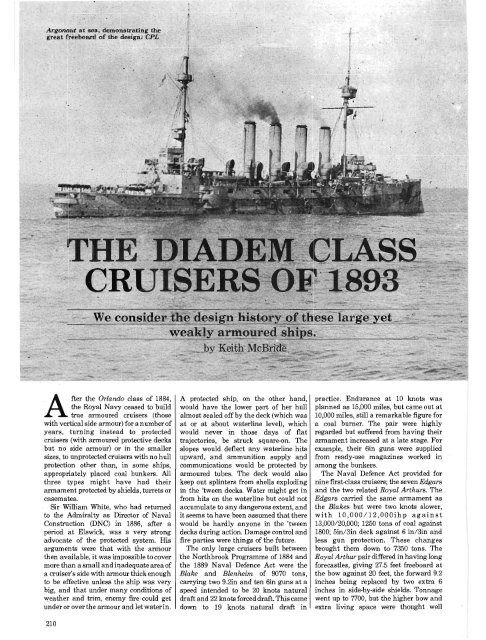You also want an ePaper? Increase the reach of your titles
YUMPU automatically turns print PDFs into web optimized ePapers that Google loves.
Argonaut at sea, demonstrating the<br />
gleat freeboard of the desigru CPtr<br />
fter the Orlando class of 1884,<br />
the Royal Navy ceased to build<br />
true armoured cruisers (those<br />
with vertical side armow) for a number of<br />
years, turning instead to protected<br />
cruisers (with armowed protective decks<br />
but no side armour) or in the smaller<br />
sizes, to unprotected cruisers with no hull<br />
protection other than, in some ships,<br />
appropriately placed coal bunkers. All<br />
three types might have had their<br />
armament protected by shields, turrets or<br />
casemates.<br />
Sir William White, who had returned<br />
to the Admiralty as Director of Naval<br />
Construction (DNC) in 1886, after a<br />
period at Elswick, was a very strong<br />
advocate of the protected system. His<br />
arguments were that with the annour<br />
then available, it was impossible to cover<br />
more than a small and inadequate area of<br />
a cruiser's side with armour thick enough<br />
to be effective unless the ship was very<br />
big, and that under many conditions of<br />
weather and trim, enemy fire could get<br />
under or over the armour and let water in.<br />
2I0<br />
A protected ship, on the other hand,<br />
would have the lower part of her huil<br />
almost sealed off by the deck (which was<br />
at or at about waterline level). which<br />
would never in those days of flat<br />
trajectories, be struck squareon. The<br />
slopes would deflect any waterline hits<br />
upward, and ammunition supply and<br />
communications would be protected by<br />
armoured tubes. The deck would also<br />
keep out splinters from shells exploding<br />
in the 'tween decks. Water might get in<br />
from hits on the waterline but could not<br />
accumulate to any dangerous extent, and<br />
it seems to have been assumed that there<br />
would be hardly anyone in the 'tween<br />
decks during action. Damage control and<br />
fire parties were things ofthe future.<br />
The only large cruisers built between<br />
the Northbrook Programme of 1884 and<br />
the 1889 Naval Defence Act were the<br />
Blake and Blenheim of 9070 tons,<br />
carrying two 9.2in and ten 6in guns at a<br />
speed intended to be 20 knots natural<br />
draft and 22 knots forced draft. This came<br />
down to 19 knots natural draft in<br />
practice. Endurance at 10 knots was<br />
planned as 15,000 miles, but came out at<br />
10,000 miles, still a remarkable figure for<br />
a coal burner. The pair were highly<br />
regarded but suffered from having their<br />
armament increased at a late stage. For<br />
example, their 6in guns were supplied<br />
from ready-use magazines worked in<br />
among the bunkers.<br />
The Naval Defence Act provided for<br />
nine first-class cruisers; the seven -Edgars<br />
and the two related Royal Arthurs. "fhe<br />
Edgars carried the same armament as<br />
the Blakes but were two knots slower,<br />
with 10,000/12,00Oihp against<br />
13,000/20,000; 1250 tons of coal against<br />
1800; Sin,z3in deck against 6 in,zSin and<br />
less gun protection. These changes<br />
brought them down to 7350 tons. The<br />
Royal Arthur pair differed in having long<br />
forecastles, gtving 27.5 feet freeboard at<br />
the bow against 20 feet, the forward 9.2<br />
inches being replaced by two extra 6<br />
inches in side-by-side shields. Tonnage<br />
went up tn 7700, but the higher bow and<br />
extra living space were thought well



